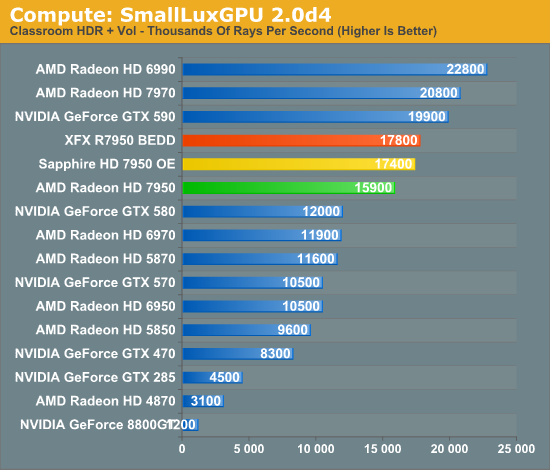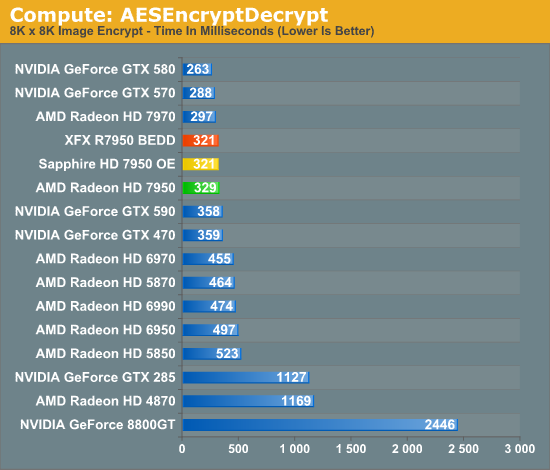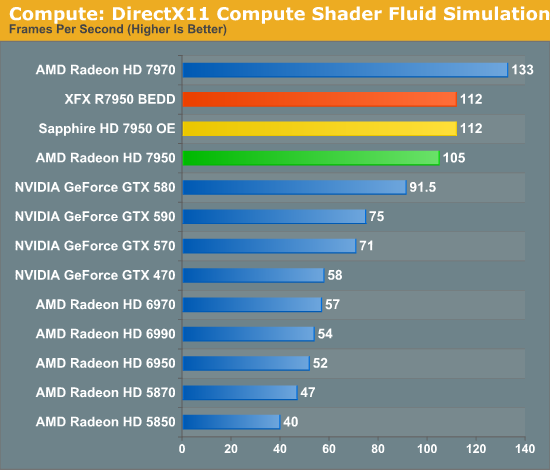AMD Radeon HD 7950 Review Feat. Sapphire & XFX: Sewing Up The High-End Market
by Ryan Smith on January 31, 2012 9:02 AM ESTCompute Performance
Moving on from our look at gaming performance, we have our customary look at compute performance. Since compute performance is by definition shader bound, the 7950 is at a bit of a disadvantage here compared to gaming performance. Whereas ROP performance scales with the core clock, shader performance is hit by both the reduction in the core clock and the disabled CU array.
Our first compute benchmark comes from Civilization V, which uses DirectCompute to decompress textures on the fly. Civ V includes a sub-benchmark that exclusively tests the speed of their texture decompression algorithm by repeatedly decompressing the textures required for one of the game’s leader scenes. Note that this is a DX11 DirectCompute benchmark.

AMD’s greatly improved compute performance continues to shine here, though in the case of Civilization V it’s largely consumed by just closing the previously large gap between the GTX 500 series and the Radeon HD 6000 series. As a result the 7950 falls ever so short of the GTX 580, while the factory overclocked Sapphire and XFX cards give the 7950 enough of a push to come within 5% of the 7970.
Our next benchmark is SmallLuxGPU, the GPU ray tracing branch of the open source LuxRender renderer. We’re now using a development build from the version 2.0 branch, and we’ve moved on to a more complex scene that hopefully will provide a greater challenge to our GPUs.

Under SmallLuxGPU the 7970 enjoyed a large lead over the GTX 580, and this continues with the 7950. Even though the 7950 is well behind the 7970—to the tune of 24%—it’s still 33% ahead of the GTX 580 and the lead only grows from there. Meanwhile the XFX and Sapphire cards can catch up to the 7970 somewhat, but as this is truly a shader-bound test, you can’t make up for the lack of shaders units on the 7950.
For our next benchmark we’re looking at AESEncryptDecrypt, an OpenCL AES encryption routine that AES encrypts/decrypts an 8K x 8K pixel square image file. The results of this benchmark are the average time to encrypt the image over a number of iterations of the AES cypher.

In spite of being a compute benchmark, AESEncryptDecrypt is not particularly sensitive to GPU performance, showcasing the impact that setup times can have. The 7950 trails the 7970 by 10%, and overclocking doesn’t change this much. Unfortunately for AMD NVIDIA is still the leader here, showing that AMD’s compute performance still has room to grow.
Finally, our last benchmark is once again looking at compute shader performance, this time through the Fluid simulation sample in the DirectX SDK. This program simulates the motion and interactions of a 16k particle fluid using a compute shader, with a choice of several different algorithms. In this case we’re using an (O)n^2 nearest neighbor method that is optimized by using shared memory to cache data.

With the compute shader fluid simulation we once again shift back into a compute task that’s much more shader-bound. The 7950 only reaches 80% of the performance of the 7970, once more proving the real impact of losing a CU array. This is still enough to handily surpass the GTX 580 however, with the 7950 taking a 15% lead.










259 Comments
View All Comments
chizow - Sunday, February 5, 2012 - link
You want to talk about respect while throwing out inflammatory comments like fanboy every reply while ignoring the actual facts and logic of an argument? Respect is given where its due.Anyways, like I said, just draw out the pricing history on these high-end parts for the last 5-6 years and you will see what AMD is doing here is unprecedented. At no point has one of these GPU makers ever asked for flagship prices with so little improvement over the last-gen flagships when using a new process node/GPU architecture.
If you are a reasonable person who is deserving of respect, I think you will find truth and reason in what I've written here, fanboyism and lack of respect aside.
Galidou - Sunday, February 5, 2012 - link
Find me anywhere I called you an idiot or a stupid or anything, the worse I said is that ultimate knowledge is crazyness, never called you crazy or ANYTHING, while you did it again., sad to see you have to resolve to those strategy as arguments....The lowest price I can find right now of the 7970 is 520$ and lowest I can find for 6950 is 240$, a little more than double as I said.
I said I trolled and I know it inflammatory comments and lack of respect is different, I was poking your ''facts'' and the way you react and still lack of respect toward me just shows even more...
''who is deserving of respect''
EVERYONE deserves respect and I will still respect you even if you don't for me because respect can't be bought, it is acquired or applied...
Galidou - Sunday, February 5, 2012 - link
And btw you still forgot to input the amount of memory which is 3gb that you forget everytime in your comments....Galidou - Sunday, February 5, 2012 - link
''If you are a reasonable person who is deserving of respect''I just still can't beleive you said that... ''who is deserving respect'' it's deceiving to see such lack of respect in a conversation about gpus,
I understand what you mean, Nvidia as always been about giving double the performance of last gen but they are hitting a wall where it won't be possible until they change the limit of the max TDP which is 300w, they are very close to it, I guess they left some space for double chip cards, but nvidia which isn't their strenght of watt/performance will probably have to change things if they want to squeeze double the gtx580 in their gtx680 in 300w TDP...
Considering ATI are the best at watts/performance and they only squeezed that kind of performance in 250w.....
chizow - Sunday, February 5, 2012 - link
6950 was as cheap as $180-$200 in some sales and the 7970 is $550-$600, so yes at times it was 3x.But the point remains, the 7970 does a worst job at upholding your standard than the GTX 280.
Also, it was a full 2x framebuffer, 8800GT was only 512MB, same as the 9800GX2 which was a massive amount of VRAM at the time. It was also more than the 512MB on the original 4870 with a full 512-bit bus.
Once again, the 280 was a flagship card by every metric, if you want to argue honestly over the facts, at least try to be honest about it.
Galidou - Sunday, February 5, 2012 - link
Yes you're right the 8800gt was 512mb, wasn'T there a 1gb version? I can'T remember...4870 was cheating, it used the first ddr5 memory so it doubled the bandwidth without adding die size, which helped ALOT to it'S great performance, I still like my 4870 which can almost still run everything very well...
Galidou - Sunday, February 5, 2012 - link
ok you want to go in the ''as cheap as'' well my friend got right after me a rebate with special and had a 8800gt for 150$ after everything, I was using regular price for my 8800gt at 180$, so consider a 8800gt at 150$ times 4.33 = 650$, wow, 4 times and a third....Galidou - Sunday, February 5, 2012 - link
IT WAS A FLAGSHIP CARD LOL the radeon 4870 got so close to it with a die half as big and that was what, a month and a half later... speak about flagship at 650$Galidou - Sunday, February 5, 2012 - link
worse than that, the radeon 4870 wasn't even meant to compete with the high end, AMD had left that market for single GPU but still it came SO CLOSE... speak about Flagshipn amzingness that doubles the previous generation.....Galidou - Sunday, February 5, 2012 - link
If you find something to say against my last comment I'm over with you, your closed mind will be the strognest I have ever seen. He will find a reason of the gtx 280 selling so high because of the Nvidia's CEO not having enough food on the table so they had to adjust the price....Poor them, send them food, they're starving!!